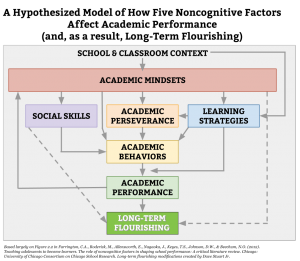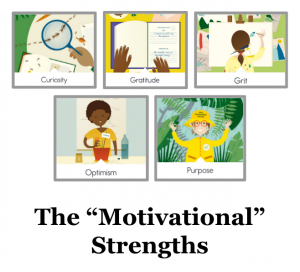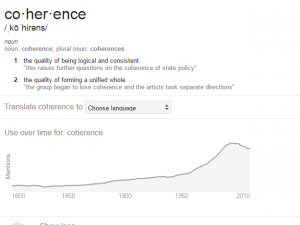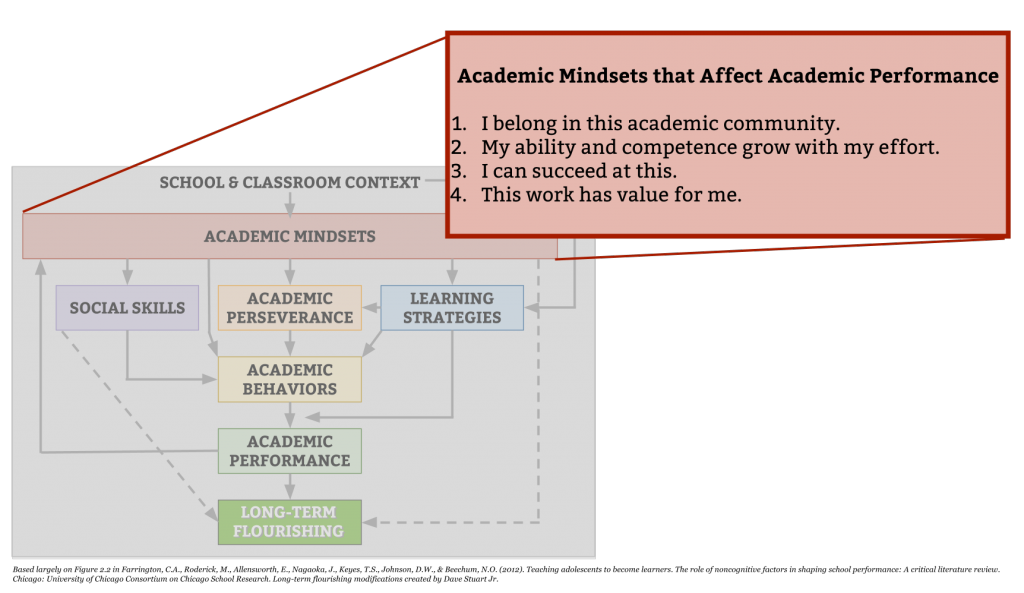
Recently, I proved to Alexis that her ability and competence could improve with effort. On her first world history test, she did poorly on the map portion and, during our first practice session in study hall following the test, did not improve much even when I walked her through a basic retrieval practice technique. (In other words, I gave her a learning strategy — see the blue rectangle in Figure 1 — but it wasn't doing much good.) During this first study session, I also told her repeatedly that our goal was to improve over time through consistent effort and effective strategies (that is, I was communicating an accessible definition of success [improvement over time] and a growth theory of intelligence).
By the second unit test, Alexis had mastered the retrieval practice technique for geographic locations and had used it enough to score perfectly on the map portion of the test. I came to her afterwards, gave her the page displaying her perfect section score, and told her to put it somewhere that she would regularly see it to remind herself of the truth that she can get better at things through her effort. Though Alexis' progress in the class overall remains slower than I would like, this story (and her continued weekly attendance at study hall) suggests to me that she's headed in the right direction.

Why Growth Mindset and the Character Strengths are Inadequate Tools for Analyzing Student Struggles
The problem with both growth mindset and character strengths (see Figure 2) — the two of which comprise the bulk of what I had written on noncognitive factors prior to the fall of 2016 — is that they are too incoherent to serve as analytical tools. The character strengths, on the one hand, are too unwieldy. If I have to sit there and say, “Well, Alexis lacks optimism and grit, and I remember that one time where she lacked gratitude, and also, she hasn't indicated a driving sense of purpose,” I don't really know how to help her. I'm left with too many directions, too many ways in which to spin my wheels. On the other hand, growth mindset is too small a peephole into the noncognitive factors — it's more likely to miss a given student scenario than it is to explain it. Even worse, with growth mindset having been subjected now to widespread buzzwordification, nowadays it is too easy to push kids into a false growth mindset where they say that their ability and competence can improve with their effort yet act as if nothing can change how well they perform on the map portion of the test.
In short, these two tools are not coherent (see Figure 3) — they both leave us longing for a unified whole, an underlying logic. If they are to impact how we practice our profession or design our schools, these things must become more intuitive, and they must do a better job making apparent to us how in the world they work together.

Thankfully, as I wrote about recently, there is a much more coherent tool. Coherence, then, to me is the single greatest benefit of both the Consortium Framework's four academic mindset statements and how the Framework conceptualizes their impact on the other noncognitive factors. (See Figure 4.)

Why the Four Academic Mindsets Give Us a Blessedly Coherent Look “Under the Hood” of Student Motivation and Student Success
More than one mindset
When a kid has a great attitude about learning, about challenge, and about our class, they are a joy to teach, and that's partially because these are the kids most likely to grow under our care. (Contrary to public opinion, teachers love it when kids grow.) These things — attitudes, beliefs, dispositions — aren't “nice to have”; they are literally foundational. Learning that lasts is built on them.
Unfortunately, the word “mindset” doesn't bring to mind this foundational level of epicness, even though a “mindset,” in the sense the research uses the term, is exactly that foundationally epic. A mindset is a belief, attitude, and disposition.
The problem with education's obsession with growth mindset is that, as Figure 4 illustrates, it's only one of four inter-locking mindsets that the literature suggests are integral to student success.
1. I belong in this academic community
This “belonging” mindset is about identity. If I don't see myself as the kind of person who does well in school — because I'm black, or because I'm a male, or because I smoke — then I am less likely to do well in school. Getting Alexis to feel a sense of belonging in both my class and my school is more than having a strong student-teacher relationship with her — though that is a start. Ultimately, my goal is for Alexis to identify herself as the kind of person who works hard at school, who gets better with time, who persists when presented with a challenge, who cares about her GPA.
2. My ability and competence grow with my effort.
This is growth mindset. I wanted Alexis to believe that she wasn't inherently, permanently bad at the map portion of the test, that it was in fact possible for her to use a simple retrieval practice strategy and master this portion of the test. To reinforce this belief, I told her to save the test she did well on and look at it to remind herself of the truth: she can learn stuff.
3. I can succeed at this.
Psychologists call this self-efficacy and self-helpers call it “believing in yourself” — I just call it practical. When Alexis was convinced in that first study session that she wasn't going to get better at the map portion, the learning strategy I was showing her didn't work — her belief short-circuited the strategy. In a later lesson, when I walked the whole class through a similar learning strategy, Alexis wasn't “on the spot” with me one-and-one, and I noticed her going along with the lesson and using the strategy. After several tries, I watched as her body language spoke of a surprising revelation — she could remember locations on a map! This was possible for her!
After that, it was just a matter of her putting in a few reps at home (academic behaviors, if we're looking at the Consortium Framework) with the retrieval practice technique we had practiced in class, and before I knew it she was walking into the second test eager to take the map portion.
4. This work has value for me.
We know this matters — it's why we come up with a hundred ways to answer those “Why do we have to do this/know this/study this?” questions. Just as you and I find it hard to motivate ourselves to do things we find pointless (and, of course, some of them are pointless and therefore ought to be satisficed), so too do our kids.
It's interesting to note, though, how closely this Value mindset is to the Expectancy one that precedes it. If I feel that I am unlikely to succeed at something, I am unlikely to value that thing. On the other hand, if I've found that I'm fairly good at a thing, I'm more likely to value it. Finally (and importantly!), if I believe I'm likely to succeed at something, or that something is very worthwhile, then I'm more likely to devote time and energy to its completion.
The mindsets push the rest
This year, I've seen dozens of Alexis' peers achieve breakthroughs similar to hers — small in the big scheme of things but big when we consider how the Consortium Framework posits that noncognitive factors work. As we aim our instruction to affect any of the four academic mindsets and to equip kids with the best learning strategies we're aware of, we start to see a flywheel affect. The mindsets encourage the kids to work better with others or ask for help (social skills), to exert greater effort and focus (academic perseverance), to use the learning strategies we teach them, and to do the work to begin with (academic behaviors). As these things happen and we direct their attention to indicators of improved academic performance, that improved performance supports their beliefs, attitudes, and dispositions toward belonging in school, working hard for an achievable success, and finding value in what they are learning along the way. As this flywheel gains momentum, they become more impervious to the bumps their bound to hit along the road, and their chance of long-term flourishing is thereby greatly increased.[hr]
Thank you, again, to Camille Farrington, Melissa Roderick, Elaine Allensworth, Jenny Nagaoka, Tasha Seneca Keyes, David W. Johnson, and Nicole O. Beechum of the University of Chicago Consortium on School Research. Their report has clarified a great deal for me. Also, thank you to Paul Tough, whose Helping Children Succeed was the first to point me toward the Consortium’s work.
Phil Nienhuis says
Thank you for your very insightful and thoughtful writing. (I’ve learned to expect this from you!) I have struggled with the same issues. While you have done so as an educator in the classroom, I have done so as a counselor in my office. I too have found the character strengths as being too vague to have much use.
This is what I have done:
First, I took the “KIPP Seven” and reduced them to the Top Three: Hope/Optimism, Self-control and Grit.
Second, two key interventions with regard to Hope/Optimism. Shane Lopez’s Hope model (Goal, Pathways, Agency, Barriers). I work through this with the client/student several times until it is understood. Seligman’s Explanatory Style. Again, I get very specific. “You got a D on the math test. Let’s work through the reasons for this and what you’re thinking about your skills and abilities. . . ”
Third, Self-Control. First: I love Grant-Halvorson’s definition of Self-Control: Self-Control is staying on task to achieve a goal, not allowing yourself to be sidetracked by by temptations, distractions or competing priorities. “You need to finish your history project tonight. You’re not excited by it. Other things you would rather do.” We then work through this model of self-control. We draw in on the “white board” on the wall. I take a pic of it. Print the pic. and have the client take it home to review and use. Second, The WOOP app.
Fourth, Grit. on the board I draw Duckworth’s “equation”: Talent + Effort = Skill; Skill + Effort = Achievement. Again, we work through through this. The client goes home with a pic to talk about with the parents and to review and master.
All this is done within the framework of Purpose in Life/Learning (“Where do you want to be when you’re 25 years old? Why?”) and Growth Mindset. (What I have found out is that almost always the student says they have a Growth Mindset, but as we work through their frustrations and difficulties with their homework we find out otherwise.
Given all this, David, you’re right. It all comes down to the four Academic Mindsets. These mindsets both give us a coherent model in which to work with our students/clients – and reveals where the problems are so they can be addressed and rectified.
Again, thanks for your insight and wisdom.